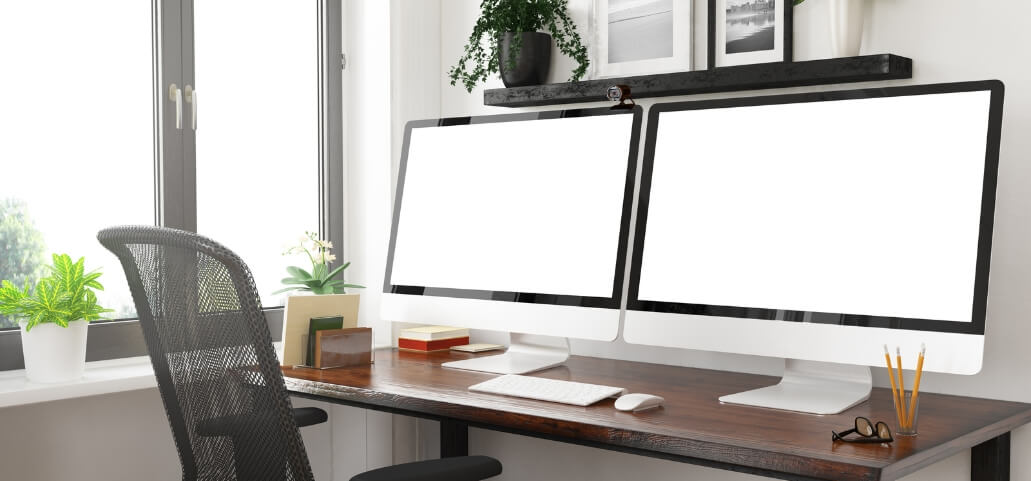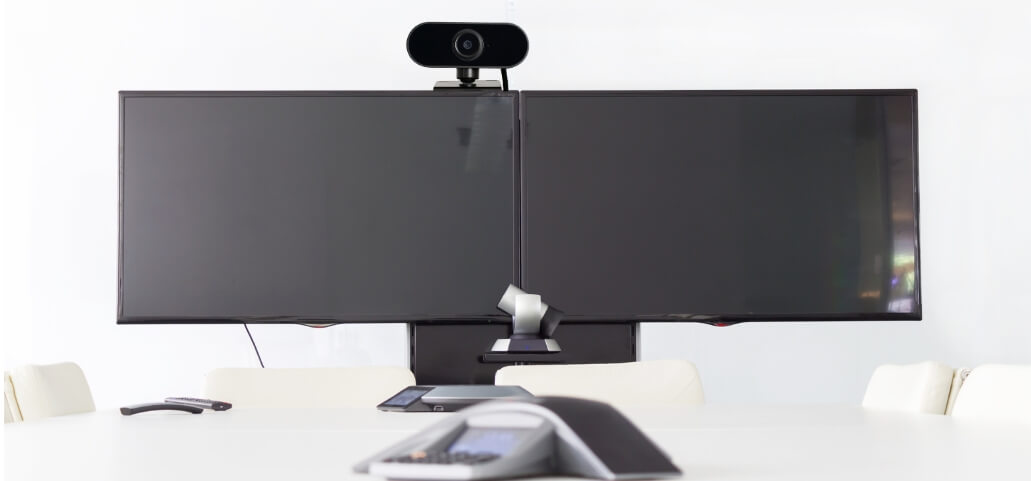Are you wondering about where to place webcam with dual monitors? Or tired of constantly adjusting your webcam every time you switch between screens while video chatting or live streaming? We have the perfect solution so you don’t need to look anywhere else! In this blog post, we will dive into the world of dual monitor setups and explore the ideal placement for your webcam. Having a properly positioned webcam can greatly enhance your virtual communication experience. So let’s not waste any more time and get ready to discover where to place webcam with dual monitors?
Factors to Consider When Deciding Where to Place Webcam with Dual Monitors
When it comes to setting up your webcam, there are several factors to consider in order to ensure the best experience for both you and your audience. We will explore three key considerations that will help you make an informed decision about the placement of your webcam.
1. Lighting and background noise:
Lighting and Background Noise Lighting plays a crucial role in how you appear on camera. Ensure that you have sufficient lighting in front of you to avoid appearing dark or shadowy. Natural light is often the best option, so try to position yourself facing a window or a well-lit area. Additionally, be mindful of background noise. Choose a quiet location or use a noise-canceling microphone to minimize distractions during your video calls.
2. Comfort and ergonomic positioning
Comfort and Ergonomic Positioning Long video conferences or meetings can be physically demanding, so it’s important to prioritize your comfort and ergonomics. Position your webcam at eye level to avoid straining your neck or looking down for extended periods. Consider using a laptop stand or external monitor to achieve the ideal height and alignment. Additionally, ensure that your seating and desk setup are ergonomically optimized to prevent discomfort and promote productivity during video interactions.
3. Eye contact with the camera
Eye Contact with the Camera Maintaining eye contact is crucial for building rapport and engagement during video conversations. Place your webcam at a position where you can look directly into the camera while speaking. This creates a more personal and connected experience for the other participants. Avoid looking at your own video feed or the faces on the screen, as it can give the impression of avoiding eye contact.
Top 3 Recommended Placements for Webcam with Dual Monitors

Are you struggling to find where to place webcam with dual monitors? We will explore the top three recommended placements that will help you achieve the optimal Top 3 Recommended Placements for Webcam with Dual Monitors
01. Above the Primary Monitor
One of the most popular placements for a webcam in a dual monitor setup is above the primary monitor. This placement offers several advantages, such as:
- Eye Level Perspective: By positioning the webcam slightly above your primary monitor, it captures a natural and eye-level perspective during video calls or recordings. This subtle adjustment not only enhances the visual experience but also creates a better sense of engagement, allowing your audience to connect with you effortlessly.
- Enhanced Facial Framing: Placing the webcam above the monitor offers a superior framing of your face, ensuring that you are the main focus of the video. With this strategic placement, your expressions and gestures are highlighted, enabling effective communication and leaving a lasting impression on your viewers.
- Efficient Use of Space: By cleverly utilizing the often-underutilized space above your primary monitor, you not only maximize the available desk space but also keep the webcam conveniently out of the way. This allows for a clutter-free workspace, enabling you to focus on your tasks without any distractions, while still maintaining a professional and polished appearance on camera.
To mount or position your webcam above your monitor, follow these simple steps:
- Choose a Sturdy Mount: Look for a webcam mount that is compatible with your monitor and offers a secure fit. There are various options available, such as clip-on mounts that attach firmly or adjustable stands that provide flexibility to position the webcam at different heights and angles.
- Find the Right Position: Determine the ideal placement above your primary monitor that provides a balanced framing of your face. Consider factors such as lighting conditions in the room, angles that flatter your appearance, and personal comfort while using the webcam.
- Mount the Webcam: Carefully attach the webcam to the chosen mount, ensuring it is stable and positioned correctly. Double-check the stability of the mount to prevent any accidental movements or falls during usage.
- Test and Adjust: Once the webcam is securely mounted, perform a video call or recording to test its position. Pay attention to the framing and angle of your face on the screen. If necessary, make small adjustments to achieve the desired framing and angle, ensuring you are comfortable and clearly visible during your video calls or recordings.
02. On Top of the Secondary Monitor
One popular option is positioning your webcam on top of the secondary monitor. We will delve into the advantages and disadvantages of this setup, and provide valuable tips on how to adjust the angle and height for the best viewing experience.
Advantages:
Eye-Level Engagement: Placing your webcam on top of the secondary monitor allows for direct eye-to-eye contact during video calls, creating a more engaging and personal connection with your audience. This can help establish trust and rapport, especially in professional settings.
Enhanced Focus: By positioning the webcam at eye level, you can maintain a more attentive and focused appearance during virtual meetings. This can help you effectively communicate your ideas and contribute to productive discussions.
Neat and Tidy Setup: Mounting the webcam on top of the secondary monitor helps keep your desk clutter-free, providing you with a clean and organized workspace. This can contribute to a more professional and polished appearance during video conferences.
Disadvantages:
Limited Mobility: Placing the webcam on top of the secondary monitor restricts its mobility, making it harder to adjust and reposition during video calls. This can be a disadvantage if you frequently need to move the webcam to show objects or documents during presentations.
Viewing Angle Limitations: Depending on the height and angle of your secondary monitor, the webcam placement on top may result in a less flattering or distorted view. It’s important to find the right balance to ensure a natural and visually appealing image.
Tips for Optimal Viewing Experience:
Adjusting the Angle: Experiment with different angles to find the most flattering and comfortable position for your webcam. It’s generally recommended to position the webcam slightly above eye level, pointing slightly downwards for a more flattering view.
Ensuring Proper Height: Ensure that the webcam is at the right height to capture your face clearly without cutting off the top of your head. This will help establish a professional and well-framed image during video calls.
Testing Lighting Conditions: Pay attention to the lighting conditions in the room to avoid shadows or overexposure on your face. Natural, diffuse lighting is usually the most flattering option, but adjusting the lighting setup according to your specific environment is essential.
03. Place a separate tripod or stand next to the monitors.
There are several creative ways to incorporate a tripod or stand into your workspace setup. By adding this element, you can enjoy more flexibility in terms of movement and angles. This placement allows you to easily adjust the position of your monitors and create a personalized viewing experience. Whether you need to tilt, swivel, or rotate your screens, having a tripod or stand nearby ensures that you can achieve the perfect setup for your needs. With this added flexibility, you can enhance your productivity and comfort while working.
Maximizing Your Webcam’s Performance with Dual Monitors: 5 Additional Tips

Webcams have become an essential tool for online communication, whether for video calls, virtual meetings, or streaming content. If you are using dual monitors, you can take advantage of some additional tips to enhance your webcam’s performance and overall experience. We will explore five practical tips that will help you make the most out of your webcam setup.
Adjust Camera Settings:
One of the first things you should do is fine-tune your camera settings. This includes adjusting parameters like brightness, contrast, and focus. By optimizing these settings, you can ensure that you have a clear and well-lit image, making your video calls or streaming content more professional and visually appealing.
Utilize Virtual Backgrounds:
Virtual backgrounds have gained popularity in recent times, and for good reason. They allow you to replace your real background with a virtual one, instantly transforming your video calls or streaming content. Virtual backgrounds can add a touch of creativity, professionalism, or privacy to your webcam setup. Whether you want to showcase your brand logo, simulate a professional office environment, or simply hide your messy room, virtual backgrounds offer endless possibilities.
Consider Lighting:
Proper lighting is crucial for a high-quality webcam experience. When using dual monitors, it becomes even more important to ensure adequate lighting across both screens. Avoid backlighting or harsh lighting conditions that may create shadows or wash out your image. Soft, diffused lighting is ideal for achieving a balanced and flattering look on camera.
Positioning and Angles:
Pay attention to the positioning of your webcam and the angles at which it captures your image. Try experimenting with different perspectives and angles to determine which look looks the most impressively realistic and attractive. A natural and captivating visual connection may be made during video conversations by positioning your webcam at eye level or slightly higher. Avoid extreme angles or awkward positions that may distort your appearance or distract your audience.
Test and Optimize:
Lastly, don’t forget to regularly test and optimize your webcam setup. Check for any software updates or driver enhancements that may improve its performance. Conduct test calls or record sample videos to assess the quality and make necessary adjustments. Keep in mind that the webcam market is constantly evolving, so staying up-to-date with the latest advancements can help you make the most of your dual monitor webcam experience.
Conclusion
For successful video conferences, it’s crucial to find the right placement for where to place webcam with dual monitors. Position it at eye level to maintain direct eye contact with your audience. Avoid tilting your head up or down, as it can be distracting. Additionally, consider lighting to prevent harsh shadows. By finding the proper placement, you’ll appear polished, prepared, and confident in virtual interactions.
Frequently Asked Questions
Q1. Where to place webcam with dual monitors to ensure the best visibility?
Answer: When setting up dual monitors, consider placing the webcam either at the top center of your primary monitor or on a mount between the two screens. This positioning ensures direct eye contact during video calls.
Q2. What's the ideal location for a webcam on a dual monitor setup for a professional appearance?
Answer: For a professional look, position the webcam slightly above eye level and centered between your dual monitors. This placement helps maintain eye contact while avoiding an upward or downward angle during video conferences.
Q3. How can I optimize the placement of my webcam with dual monitors to enhance video quality?
Answer: To enhance video quality, place the webcam in a well-lit area facing you directly. Avoid positioning it against a bright light source, as this may create glare or shadows that affect visibility.
Q4. Are there any recommended accessories or mounts for positioning a webcam with dual monitors?
Answer: Consider using adjustable webcam mounts or stands that attach securely to the top of your primary monitor or the gap between the dual screens. These accessories offer flexibility in positioning and ensure a stable setup.
Q5. Can I adjust the webcam location on my dual monitor setup for better framing and focus during video calls?
Answer: Yes, you can adjust the webcam placement for optimal framing and focus. Experiment with different positions until you find the one that provides a clear view of your face without obstructing the screens, enabling a more engaging video call experience.

